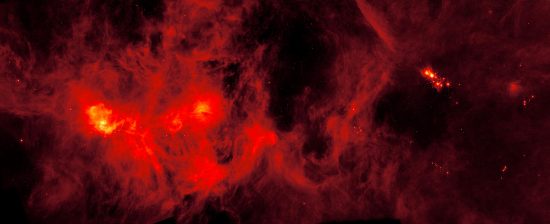Most objects in space are invisible to the naked eye.
Dec 23, 2019
NASA launched the Spitzer Space Telescope on August 25, 2003. Spitzer’s mission was to scan the sky in infrared wavelengths, using detectors kept at -268 Celsius. That frigid temperature made it possible for the telescope to “see” wavelengths as long as 180,000 nanometers. In comparison, the deepest red light frequency visible to the human eye is approximately 750 nanometers. Spitzer’s helium coolant was exhausted after five years, however, so it is now in its “warm” phase. It can still detect infrared wavelengths in the 3600 to 37,000 nanometer range, however. This is because the temperature of the instruments remains at “space ambient” of -243 Celsius.
Infrared radiation creates images (like the one at the top of the page) of the Perseus Molecular Cloud Complex. The brighter regions, such as on the left side of the image, illuminate nebular clouds. These images are only possible in infrared frequencies because dust emits almost no visible light and actually blocks it.
Many young stars in the cluster are ejecting large volumes of gas and dust. As it heats up, it “smashes into” the stellar material surrounding it. According to astrophysicists, that is what causes the jets to glow. The anomalies present in the nebula also pose mysteries when it comes to conventional understanding. The various elements in the Perseus cloud appear to be of vastly different ages: a conundrum. Since they are “packed together”, they should all have been born together in similar fashion.
According to Luisa Rebull, an astrophysicist at NASA’s Infrared Science Archive at Caltech-IPAC:
“This region is telling astronomers that there’s something we don’t understand about star formation.”
Space is filled with ions from every element, with hydrogen ions (protons) the most common. For charged particles to move, they must move in a circuit. Energetic events cannot be explained by local conditions, alone, since the effects of an entire circuit must be considered. An idea recently debunked by Electric Universe advocate, Wal Thornhill, is that while the consensus scientific worldview only permits isolated “islands” in space, the Electric Universe emphasizes connectivity with an active network of “transmission lines”.
Astronomers are still far from understanding stellar evolution. As the Electric Star theory states: “There is no reason to attribute youth to one spectral type over another. We conclude that a star’s location on the HR diagram only depends on its size and the electric current density it is presently experiencing…its age remains indeterminate regardless of its mass or spectral type. This is disquieting in the sense that we are now confronted by the knowledge that our own Sun’s future is not as certain as is predicted by mainstream astronomy. We cannot know whether the Birkeland current presently powering our Sun will increase or decrease, nor how long it will be before it does so.” We do not know the age of our own Sun!
On January 30, 2020 NASA will decommission the Spitzer Space Telescope.
Stephen Smith
The Thunderbolts Picture of the Day is generously supported by the Mainwaring Archive Foundation.













